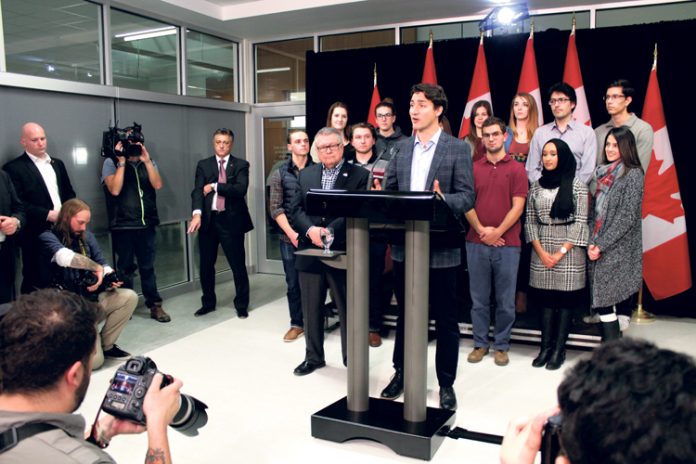
Sask. will see charges on fuel and emissions charges on output-based pricing on electricity generation and natural gas in 2019
Saskatchewan residents will see gas prices go up by 4.4 cents per litre and natural gas costs up 3.9 cents per cubic metre in 2019, but will receive an average of $598 back on their income taxes when the federally-imposed carbon tax plan comes into effect next year.
The federal government announced the details of what it is calling its pollution pricing program Tuesday. It includes fees charged on various consumable fuel products, such as gas, diesel and natural gas, and a mandated output-based pricing systems for emissions-intensive industries. The backstop is being applied to Saskatchewan, Manitoba, Ontario and Yukon, jurisdictions where the federal government has deemed governments aren’t compliant with the national climate change mandate.
In Saskatchewan, the output-based pricing will only apply to electricity generation and natural gas transmission pipelines, the two sectors the province exempted from its regulation-based emissions reduction plan.
“Canadians are seeing the costs of climate change first-hand,” the federal government said in a news release.
“From wildfires in the west to floods in the east, smoke that makes the air unsafe to breathe and heatwaves that endanger the young and the elderly. We need to act now to fight back against climate change, for our children and grandchildren.”
The release goes on to say that the three provinces and one territory that doesn’t have a carbon pricing plan “have not recognized the cost of pollution.”
It argues that three provinces that have carbon pollution pricing, B.C., Alberta and Quebec, are among the top performers in Canada when it comes to GDP growth and that 70 jurisdictions around the world are putting a price on carbon pollution. It also said that Nobel Prize-winning economists have demonstrated that carbon pricing works.
“Canadians know pollution isn’t free, and they know that carbon pollution doesn’t have boundaries. Old or young, rich or poor, urban or rural, living in the south or the north, we are all in this together. Applying practical solutions today will give all Canadians more economic opportunities and a safer and more prosperous future,” the news release said.
The fuel charge rates reflect the carbon pollution price of $20 per tonne of carbon dioxide equivalent in 2019, a mark which rises by $10 per tonne annually until it reaches $50 per tonne in 2022. That’s based on global warming potential and emissions factors Canada reports to the United Nations Framework Convention on Climate Change.
“Applying the fuel charge at higher rates over time will help to reduce greenhouse gas emissions and support clean growth while keeping costs low for Canadians and Canadian businesses. It will send a signal to markets and provide an incentive to reduce energy use through conservation and efficiency measures,” the federal government wrote.”
Effective April 2019, the fee for gas will be 4.4 cents per litre. That will rise in each of the following years to 6.6, 8.8 and finally 11. Light fuel oil, such as diesel, will start at 5.4 cents, and then raise to eight, 10.7 and finally 13.41 cents in 2022. As for natural gas, the cost will start at 2.9 cents per cubic metre, rising to 5.9 cents in 2020, 7.8 in 2021 and 9.8 in 2022.
The federal output-based pricing system will apply to electricity generation and natural gas transmission pipelines, for facilities that emit 50,000 tonnes of CO2 equivalent per year or more, while smaller facilities will be able to voluntarily opt-in over time.
The plan is designed so that all of the money collected will be returned to Saskatchewan. About 90 per cent will be returned in the form of income tax rebates. Payments will start at $305 for a single adult or the first adult in a couple. The second adult in a couple will receive $152, and parents will receive $76 for each child. Single parents will receive $152 for the first child and $76 for each subsequent child. The government estimated the average household will receive $598.
Anyone living outside of Saskatchewan’s two Census Metropolitan Areas, Saskatoon and Regina, will receive an additional 10 per cent of the amount to which they would otherwise be entitled. A single adult, for example, would receive $335.50: $305 plus ten per cent of that number, $30.50.
To receive the rebate, individuals must file their T1 income tax and benefit return.
Programs in place to offset costs for farmers, small-and-medium sized businesses
The federal plan has also built in exemptions and rebates for small businesses and to farmers and commercial fishers, though not all of the details are known yet.
Farmers and fishers will be exempted from the plan’ fuel charge for equipment used in their line of work. In other words, fishing vessels and tractors and other farm machinery fuel will be exempt. It appears as though fuel for grain drying or shipping, though, would not be exempt from the per litre charge.
A full exemption will also be granted to diesel-fired electricity generation in remote communities and for aviation fuel in the territories.
As for small businesses, municipalities, universities, schools, colleges, hospitals, non-profits and Indigenous communities, monetary support will be provided to those deemed eligible.
Saskatchewan small and medium-sized businesses will receive $30 million in 2019-20, while municipalities, hospitals and schools will receive $15 million. There are no details yet as to what that support will entail, or how the federal government will decide who is eligible.

